Chip Kelly displays unconventional intelligence in frenetic free agency

If there's one thing Chip Kelly has proven since he became the coach of the Philadelphia Eagles, it's this: he will assemble the team he wants, and there's the damned door if you don't like it. Take a cheesesteak on your way out.
• NFL rumors: Latest free-agency, trade-block buzz from around league
2015 NFL Free Agent Tracker, Grades
Kelly first proved this when he cut DeSean Jackson in March of last year, allowing the receiver to join the divisional rival Redskins without a second thought. Jackson's unwillingness to re-structure his contract, along with Kelly's preference for receivers who can contest press coverage, made that move inevitable. Kelly relied on Jeremy Maclin to replace Jackson, and Maclin responded with a career year in 2014, catching 85 passes for 1.318 yards and 10 touchdowns—despite the fact that he was coming off a torn ACL that robbed him of the entire 2013 campaign.
The 2014 power struggle was resolved early in the new year, with general manager Howie Roseman relegated to Executive Vice President of Football Operations, and Kelly firmly in control of personnel, which he insisted on from his first press conference in Philadelphia. Free of any constraints, Kelly went to work as quickly as possible to redefine the Eagles in his image. He traded running back LeSean McCoy to the Bills for linebacker Kiko Alonso and released pass-rusher Trent Cole in a span of hours in the first week of March, and deemed Maclin to be an expendable free agent.
[daily_cut.nfl]And then, on March 10, Kelly got free agency off to a big bang by trading quarterback Nick Foles to the Rams for quarterback Sam Bradford. As that was happening, the Eagles were talking with different veteran running backs, engaging in talks with Frank Gore and Ryan Mathews before landing ex-Cowboys back DeMarco Murray with a five-year, $42 million contract with $21 million guaranteed. Oh, yeah—he also gave former Seahawks cornerback Byron Maxwell a six-year, $63 million deal with $25 million guaranteed, placing the first-year full-time starter and former reserve among the NFL's highest-paid at his position.
It's been a whirlwind time period, reminiscent of Jimmy Johnson's early days with the Cowboys, Bill Belichick's early tenure with the Patriots and the roster churn-and-burn Pete Carroll engineered through his first three years in Seattle. Skeptics of Kelly's approach would say that it also mirrors the dumpster fire that became Josh McDaniels' time in Denver, but when you look at all the moves one-by-one, it's clear that not only does Chip Kelly have a plan... he may be right about every single move he's made.
• NFL Mock Draft 5.0: How does Mariota fare after so-so pro day?
Replacing McCoy with Murray
In truth, the Eagles traded McCoy for Alonso and Murray from a cap perspective—Alonso is on a rookie deal that will represent cap hits of less than $1 million in both 2015 and '16. McCoy's deal with the Eagles stuck the team with a cap hit of nearly $12 million in '15, and by all accounts he wasn't interested in re-negotiating. Murray's annual salary is $8.4 million, which doesn't represent his '15 cap charge, but I'd be very surprised if Murray's hit doesn't come quite a bit under McCoy's. Kelly understands that going back to his days as the head coach and offensive mastermind at Oregon, he has a system that creates career years for running backs.
Eagles swing for the fences in signing DeMarco Murray away from Cowboys
McCoy had his two best years under Kelly, especially a 2013 season in which he led the NFL in carries (314), rushing yards (1,607) and total yards (2,146). Murray led the NFL in all those categories for the Cowboys in 2014 (392 carries for 1,845 yards and 2,261 total yards). Murray's workload, and the fact that he ran behind perhaps the NFL's best run-blocking line in 2014, may have some worrying about regression in his new offense.
"In this offense, we keep you guessing," McCoy told me about Kelly's system last July. "There are times when the defense says, 'We've seen this—it's a pass.' Or they think it's a run, and it's totally the opposite. And I think that when you give a defense so many different looks that all look the same—the formations all look the same—it's hard to really study them.
"Our offense is a big-play offense. We're not that kind of typical, boring three-yard offense; we keep the chains moving. That's big here, because I feel that I get the most out of myself as far as quickness and explosion."
Murray will have to adapt to more zone-blocking than Dallas's power/counter/trap-gap blocking scheme, and he won't be running behind a fullback too often. But the general feeling is that Murray can adapt. Factor in Darren Sproles, and Ryan Mathews (who the Eagles are also signing), and Kelly has as gifted a running backs roster as has been seen in recent NFL history.
Acquiring Alonso
Alonso missed the entire 2014 season with a torn ACL, so it may be hard for some to remember how great he was in his rookie season for the Bills. Buffalo's second-round pick in '13, Alonso had an amazing season with 76 solo tackles, four interceptions, two sacks, 13 quarterback hurries and 56 run stops. He turned very quickly into a rare three-down linebacker, as comfortable dropping into coverage as he was bashing away at running backs at the line of scrimmage. He'll be a major upgrade alongside Mychal Kendricks in a Billy Davis defense that needed all the help it could get in the back seven last year.
• BEDARD: Rest assured, Belichick and the Patriots have a plan
"Very instinctive football player, runs extremely well, he's tall, he's long, he's what we're looking for, he's all about football," Kelly said of Alonso, who of course played for him at Oregon, at his Wednesday press conference. "He's just a smart, intelligent football player that's working very, very hard to get himself back in position to play."
Releasing Trent Cole
Cole amassed 14.5 sacks over the last two seasons in his transition from 4–3 defensive end to 3–4 outside linebacker, and he came to his contract re-negotiations with some leverage. That said, the Eagles saved $8.425 million in cap space by cutting him, and Cole will be 33 in October.
With rare exceptions, speed rushers in their early thirties fall off precipitously, and while we're not absolutely predicting that for Cole in his NFL future (he signed a two-year, $16 million contract with the Colts that gives him $8 million guaranteed), but it's pretty easy to bet the under, and that's exactly what Kelly did.
[pagebreak]
Letting Maclin walk
Maclin came close to the 1,000-yard mark every season from 2010 through '12, but it wasn't until Jackson was jettisoned that he proved his worth as a number-one receiver. And while he did that with his breakout season, Kelly could just as easily point to the fact that Maclin had that career year in his offense as Exhibit A that he was fungible. On the other hand, the Chiefs, who gave Maclin a five-year, $55 million contract with $22.5 million guaranteed. That's more than Kelly was willing to shell out, and based on Maclin's career productivity curve, he's probably not wrong.
Now, he'll have to decide whether second-year man Jordan Matthews is ready to wrestle his way out of the slot, if Riley Cooper can bounce back in 2015 and which members of a very loaded draft class he'll want to acquire. The Chiefs were in an opportunity-cost sinkhole because they didn't have a single receiver catch a touchdown pass in 2014. Kelly could afford to take the Moneyball route here.
Trading Foles for Bradford
Kelly has long been a Bradford advocate, and it's easy to see why—when you go back to his Oklahoma tape, you see a quarterback who was entirely familiar and comfortable with a spread-style offense that had hurry-up elements and some route complexity, requiring functional mobility from the quarterback. It's just as easy for Kelly to go back to Bradford's rookie season with the Rams, when Pat Shurmur was his offensive coordinator and Bradford won the AP Offensive Rookie of the Year, as evidence that a Bradford-Kelly match could be a perfect fit.
Eagles trade Nick Foles to Rams for Sam Bradford and draft picks
Not only does Kelly's offense create designed openings for a quarterback and automatically keep the first read opening, but Shurmur is Kelly's offensive coordinator, and thus will be Bradford's offensive coordinator again. And if you've seen St. Louis' offense under Brian Schottenheimer in recent years, it's tough to imagine anyone succeeding in that reductive system over time. So, in the abstract, Bradford should see a major uptick in production and efficiency under Kelly and Shurmur.
Of course, Bradford's red flag is a horrible injury history that's seen him play in just 49 of a possible 80 regular-season games, and miss the entire 2014 season.
Kelly has isolated Bradford as a player, and he clearly believes in what he sees—and he sees Bradford as a product of his environment.
"When you're assessing individual players, I'm watching skill set," Kelly said Wednesday. "How does he throw the ball, can he make this throw, can he make that throw, have you seen him throw the out, have you seen him throw a comeback, have you seen him throw a dig, have you seen him throw a deep ball?
"Sometimes when the quarterback throws the ball directly where it needs to be and the receiver drops it, is that the receiver's fault or is that the quarterback's fault? So what does it go down as for the quarterback? That's 0-for-1, and he doesn't gain any yards on it. How are his drops? How does he work? There's a lot of different things into it. And again, the part about him being a worker and those things, I think we had some great information because Pat had the opportunity to coach the kid for a year."
Many issues remain unresolved for teams making quarterback changes
Bradford will have to re-negotiate his contract to make this experiment worthwhile, of course—he's got a $12,985,000 cap hit for 2015 as it currently stands, and the Eagles would incur no financial penalty if they cut him outright. So, let's assume Bradford will agree to a friendlier number, and play under a one-year test pattern for his NFL future.
As for Foles? Kelly inherited Foles, and while there are elements of Foles' game that matches up with Kelly's ideal at the position, Foles was never a great mobile quarterback in college, and that didn't change in the NFL. It wasn't a problem in 2013, when Philly's offensive line was a bastion of stability, and a relatively unhurried Foles threw for 27 touchdowns and two interceptions in 10 starts. However, when injuries scuttled that same line in '14, Foles was obviously and profoundly negatively affected by that increased pressure, throwing 13 touchdowns and 10 picks in eight starts. By no means is Foles a sure thing—he may turn out to be a legitimate sub-franchise quarterback over time, or he could be a hothouse one-year wonder in an ideal circumstance. At worst, Bradford for Foles is a wash.
Signing Maxwell to a top-tier contract
If we're defending all of Kelly's moves, this is the toughest to support. The Eagles signed Maxwell to a six-year, $63 million with $25 million fully guaranteed. That's top-tier cornerback money, and while Maxwell has played well at times through his two NFL seasons as a starter, that's a lot of cheese for a guy who hasn't yet fully proven himself in that realm at the position.
After the departures: Teams impacted most by losses in free agency
"We've seen Byron firsthand," Kelly said. "We got a chance to see him when we played Seattle and obviously we felt he was the best corner that was available in terms of how we could fit it, what fits with us money wise. He's what we're looking for, again, in corners: tall, long, physical, athletic, smart. He's an intelligent football player, so I think he's a good fit."
In Philadelphia's Week 14 loss to Seattle, Maxwell gave up four receptions on seven targets for 31 yards and a 68.2 quarterback rating, which is about in line with his career numbers—in 2014 overall, he allowed 55 catches on 85 targets for 67 yards, one touchdown, three picks and a 78.5 opposing quarterback rating. Maxwell is a big (6'0", 207), physical press cornerback in the Seattle style, and he fits what the Eagles do in many ways. The real question here is how well and how quickly he adapts to being the primary target of every opposing offense.
The health issue
Kelly is taking risks on many players with injury histories, but he also has reasons to believe in injury luck. Football Outsiders has a metric called Adjusted Games Lost, which details how teams are truly affected by injuries, especially to key starters. Through Kelly's first two seasons with the Eagles, the team has ranked first and fifth in AGL, and Kelly did his best to discount the injury factor mid-week.
NFL free agency snaps: Did Brees' contract impact Graham trade?
"We don't want to bring in injured players, but I think the players that are available, there has to be a reason," he said. "Some guys are available because it's a money reason and you don't have the cap room or you're not willing to go that high for that individual player, and some players are available because there was an injury."
Kelly spoke Thursday about his well-documented Sports Science methods and beliefs, and whether that could help mitigate those risks.
"That's what we try to do here. If a guy breaks a lag, he breaks a leg. I don't know if there's anybody from a Sports Science standpoint who can heal a broken bone very quickly. Sometimes you have to look at the specific injuries, and instead of making a blanket statement, 'Oh, we're not gonna do this, we're not gonna do that,' I think the key point is to look at the injuries and really spend some time relying on our trainers and our medical staff in terms of what they think from a recovery standpoint."
And in the end, that's the key to this deluge of transactions—Kelly is trying as best he can to manage his team's salary cap with calculated risks and undervalued assets. It's a derivation of the Moneyball approach that has worked with varying results for multiple teams, but he's all in.
As the coach said when asked of the benefit to buying low on players, "We all have the same amount of money, so if you buy high on everybody, you're going to be over the cap."
That's Chip Kelly's motto, now and in the future. The wisdom of these moves will be debated strongly, but this is clear—Kelly will succeed or fail entirely on his own terms.
RECENT BLOCKBUSTER TRADES IN NFL
Recent Blockbuster Trades in the NFL
2015: Jimmy Graham, Max Unger
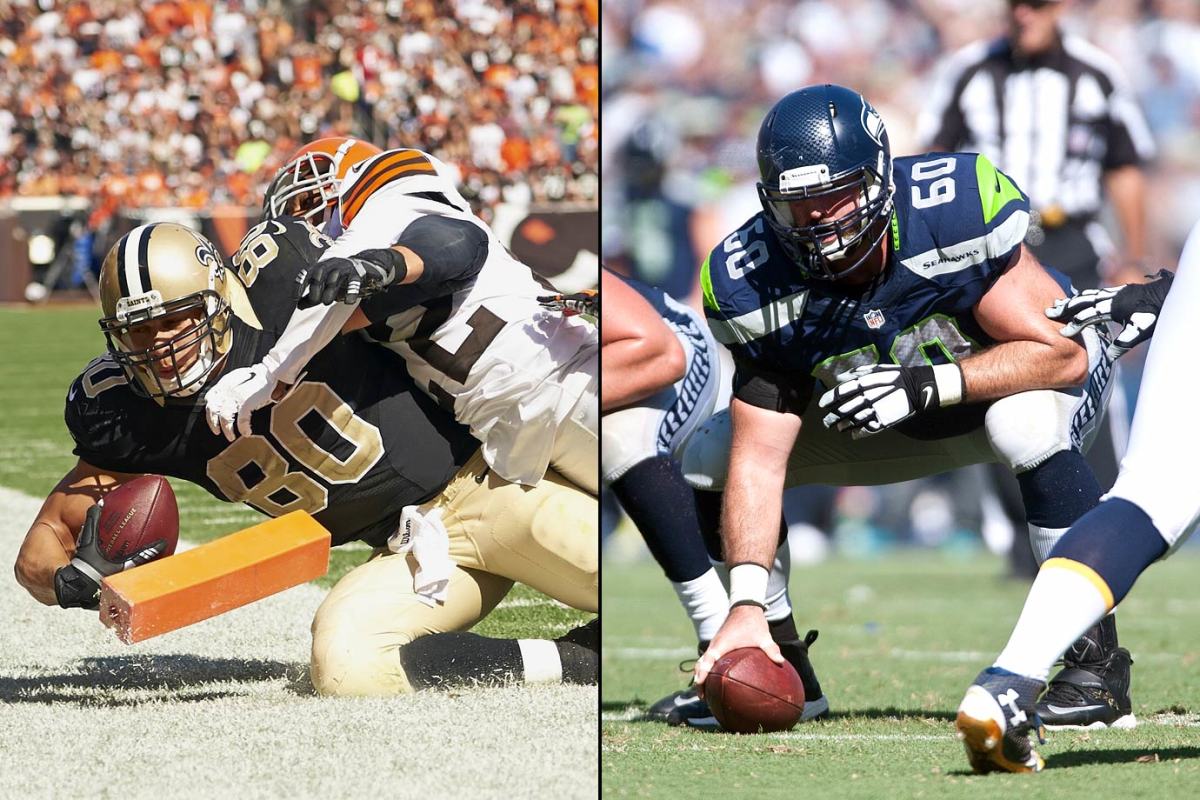
The New Orleans Saints and Seattle Seahawks sent shockwaves on the opening day of free agency in 2015 with the trade of center Max Unger and a first-round pick for tight end Jimmy Graham and a fourth-round pick. The Seahawks, coming off back-to-back appearances in the Super Bowl, sorely needed to improve their receiving corps and seem to have gotten the job done in grand fashion.
2015: Nick Foles, Sam Bradford
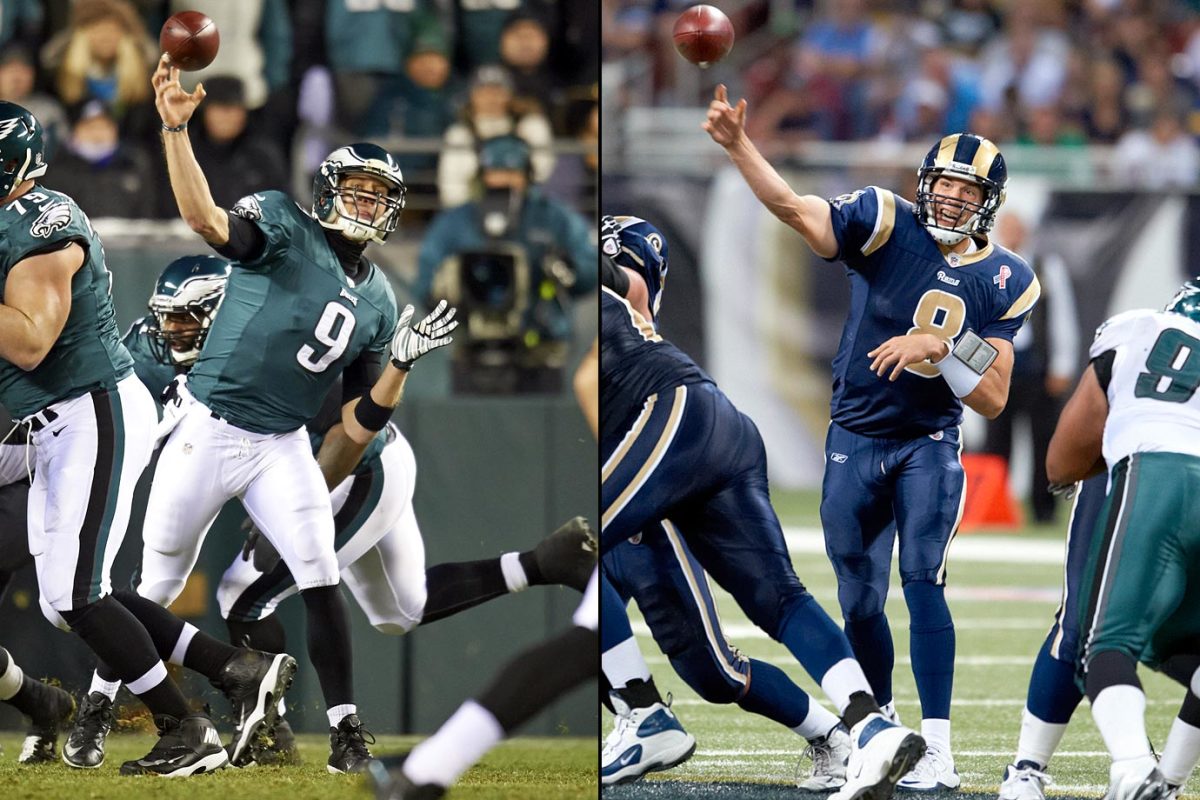
A pair of injury-plagued starters, Nick Foles and Sam Bradford traded places on the opening day of free agency in 2015 . The Philadelphia Eagles surprisingly shipped Foles and a fourth-round pick and conditional second-rounder to the St. Louis Rams for Sam Bradford and a fifth-round pick. Bradford missed all of the 2014 season with a torn ACL, while Foles sat out eight games that season with a broken collarbone.
2015: LeSean McCoy
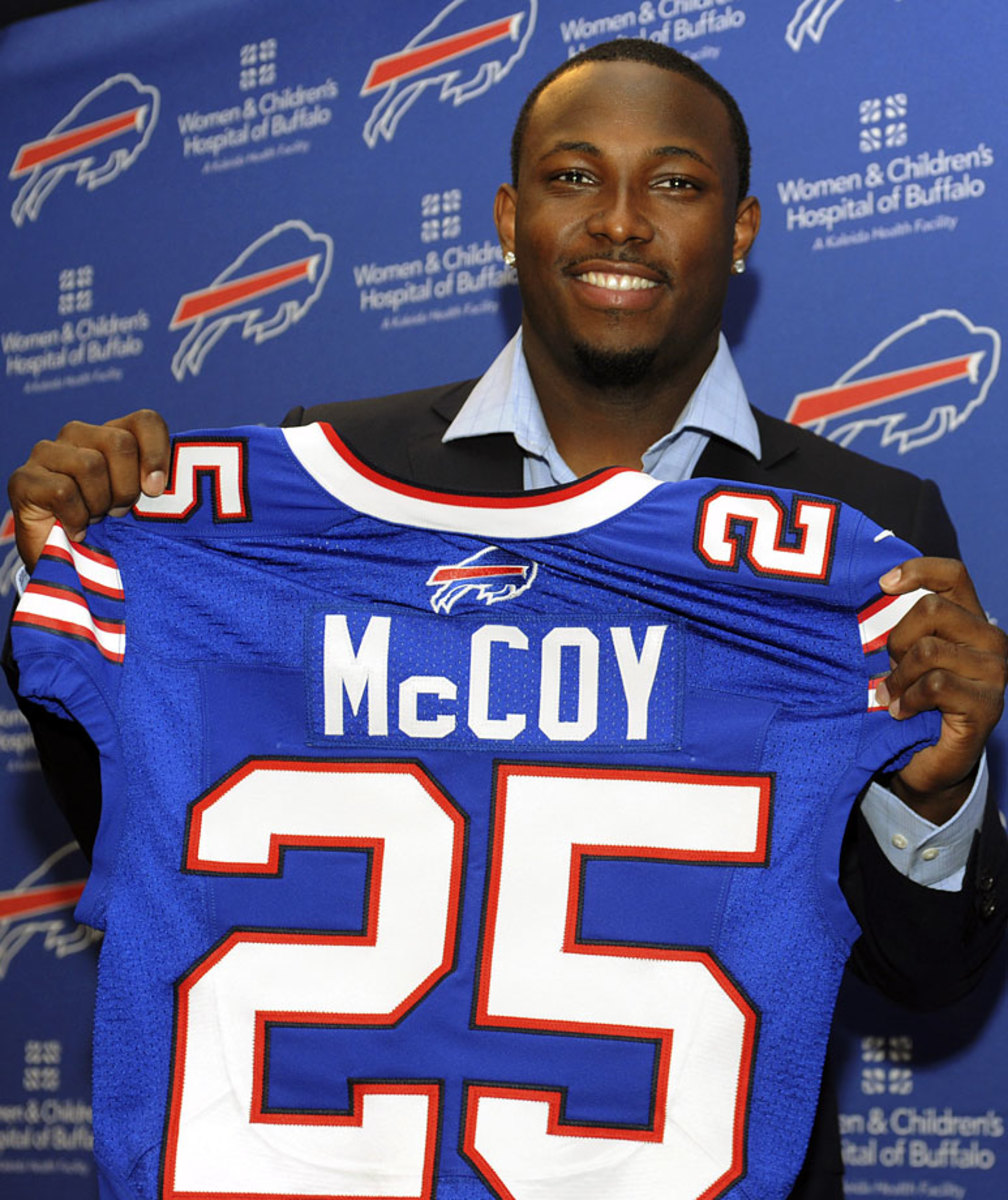
The Philadelphia Eagles stunned the NFL world by trading 2013 NFL rushing champion LeSean McCoy to the Buffalo Bills for linebacker Kiko Alonso in early March 2015. The move was yet another signal that third-year Eagles coach Chip Kelly intended to build a team his way, whether or not it made sense to pundits. For New Bills coach Rex Ryan it was a bold acquisition, especially in exchange for a linebacker who missed all of the 2014 season with a torn ACL
2013: Darrelle Revis
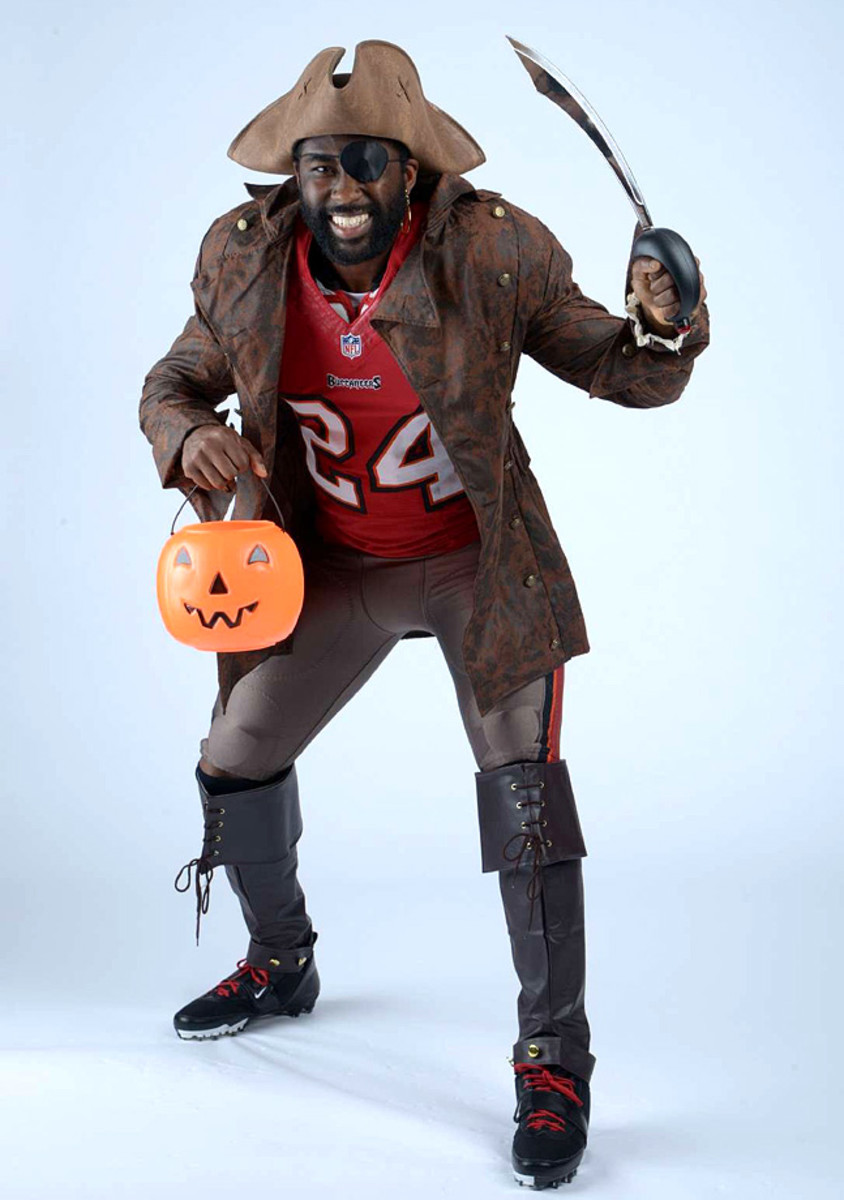
The New York Jets refused to meet Darrelle Revis’ contract demands and traded him to the Tampa Bay Buccaneers in April 2013 for a first-round pick in 2014 (Sheldon Richardson) and a fourth-rounder in 2015. Revis, the top corner in the league but also coming off ACL surgery, lasted a year in Tampa; then signed with the Patriots and won a Super Bowl before leaving after one season to rejoin the Jets.
2013: Percy Harvin
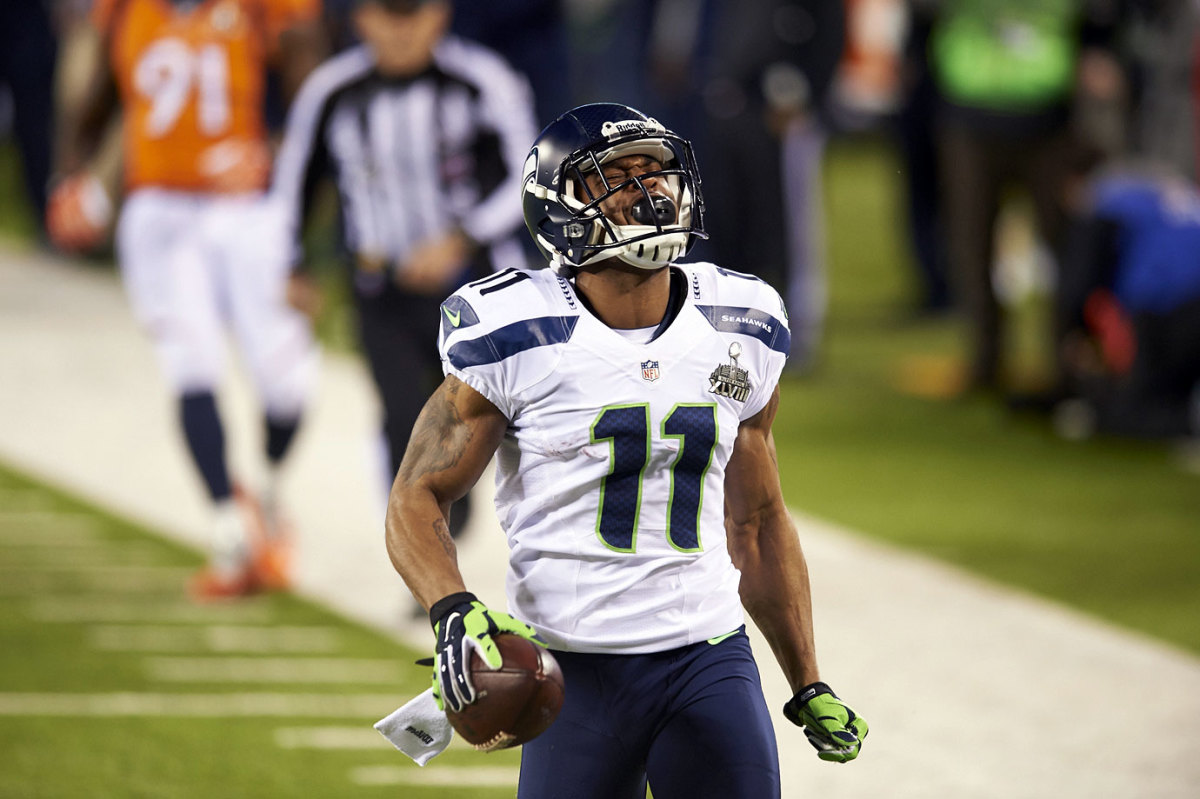
Percy Harvin to the Seattle Seahawks from the Minnesota Vikings for first- and seventh-round picks in 2013 and a third-round pick in 2014 looked like a horrible move by the Vikings at the time of the deal. In hindsight, not so bad. And though the Seahawks won a Super Bowl with Harvin on the field in February 2014, he wore out his welcome and was traded to the New York Jets the following season.
2013: Trent Richardson
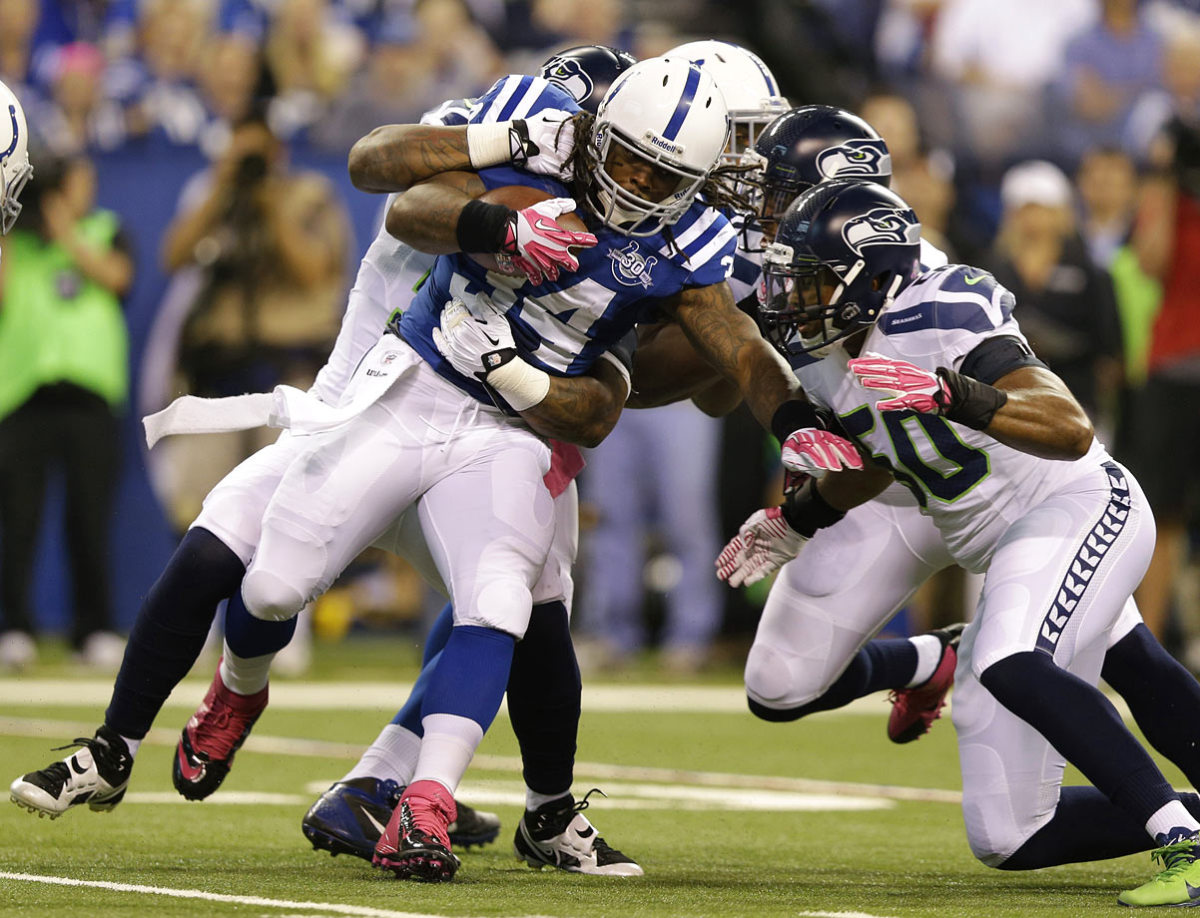
Only two games into the 2013 season, the Cleveland Browns shocked the NFL by trading their first round pick from the year before, Trent Richardson, to the Indianapolis Colts for a first round pick in 2014. The Colts were seeking a replacement for the injured Vick Ballard, while new Cleveland management were rumored not to be terribly fond of either of Cleveland's 2012 first round picks (Trent Richardson and Brandon Weeden). Richardson underperformed with the Colts in his two years with the team.
2012: Robert Griffin III
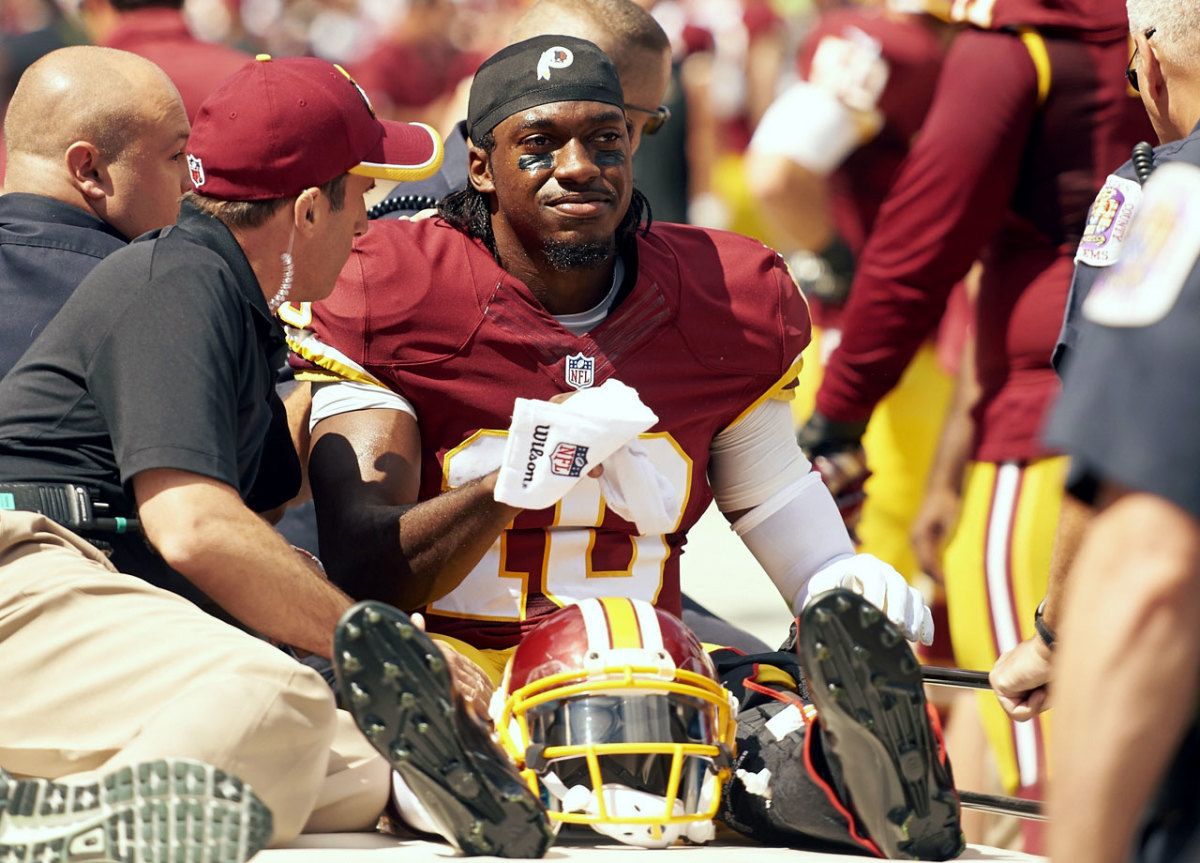
After surviving a full year with Rex Grossman at the helm, the Washington Redskins decided to make one of the largest draft-day trades in NFL history in an attempt to draft a franchise quarterback. The Redskins acquired the second overall pick in the 2012 draft, with the intention of picking Robert Griffin III, from the St. Louis Rams for three first round picks and a second round selection. Griffin would go on to win Rookie of the Year in 2012 and lead the Redskins to the playoffs, but his season would end with a torn ACL in the divisional game against the Seahawks. RGIII has struggled with both his play and injuries ever since.
2012: Brandon Marshall
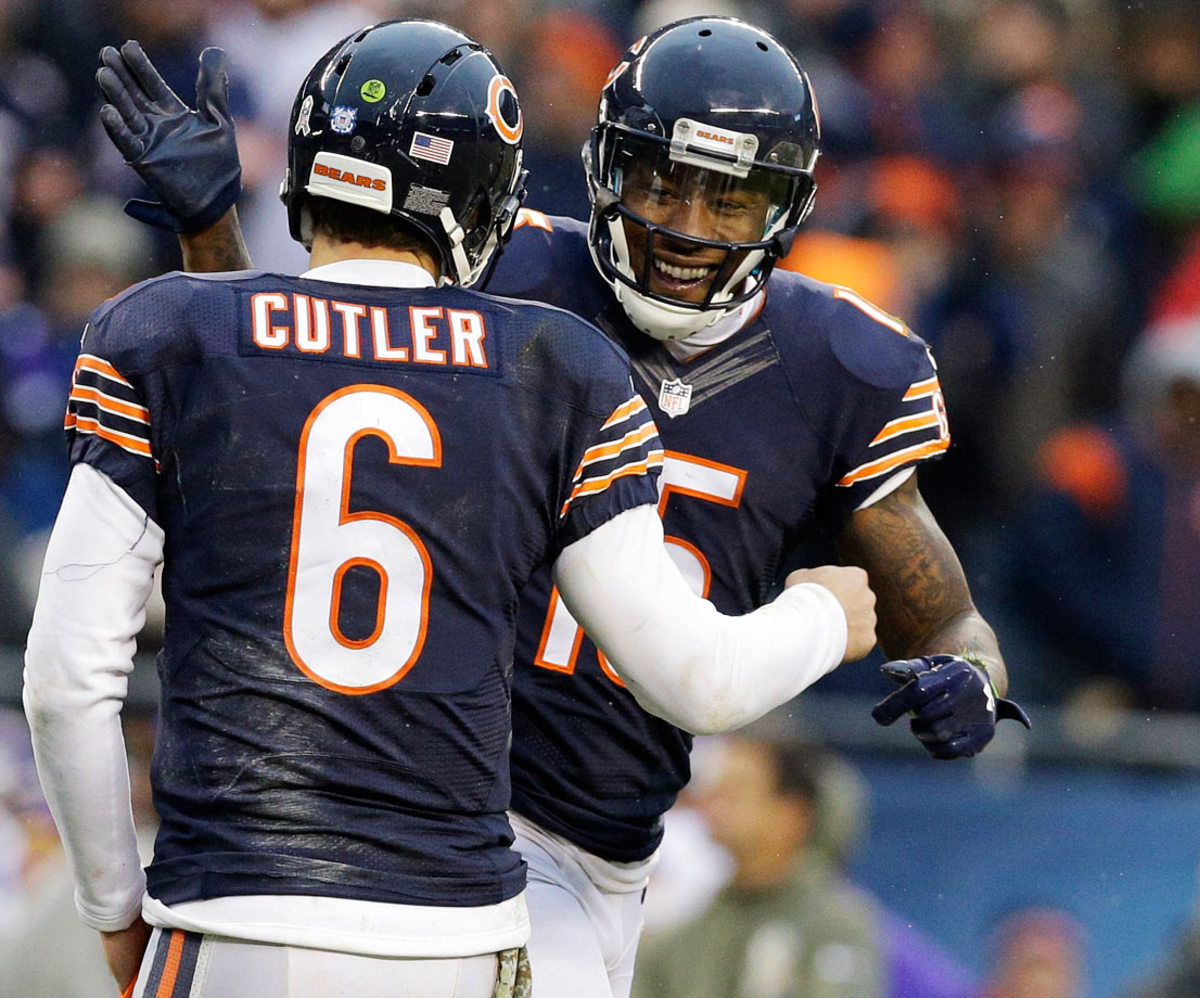
Shortly after firing their offensive coordinator and quarterbacks coach, the Bears traded two third-round picks to acquire Brandon Marshall from the Miami Dolphins. Why? To please Jay Cutler. A combo that had been wildly successful as teammates in Denver, the Bears brought in the volatile star receiver for a fairly modest price. After three prosperous seasons with Chicago, during which he scored 31 touchdowns, Marshall was sent to the Jets for a fifth-round pick.
2009: Jay Cutler
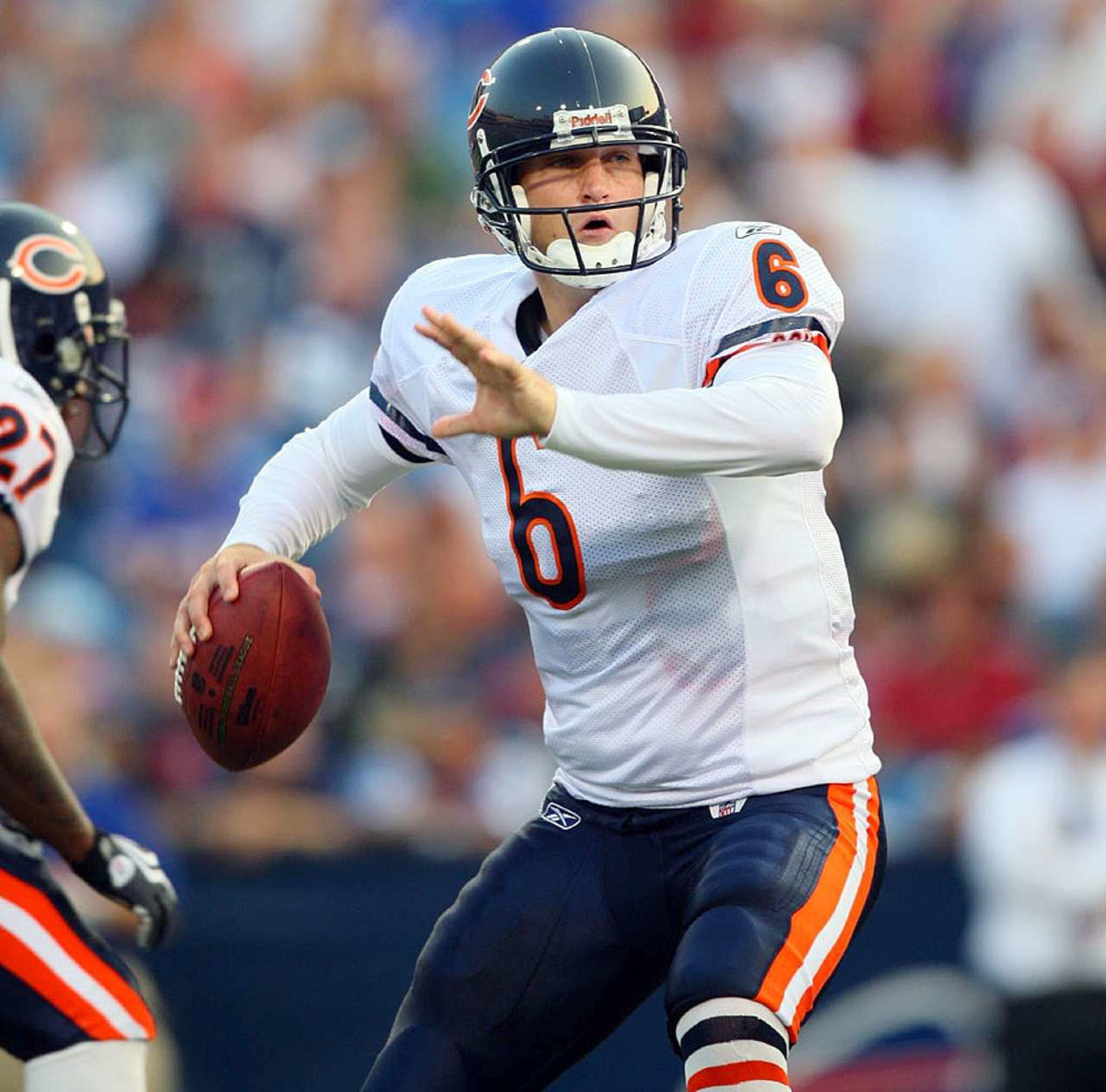
After requesting a trade because of the hiring of Josh McDaniels, Jay Cutler found himself out of Denver and in Chicago in a three-team trade that changed the course of the Pro Bowler's career and energized the Bears. Only 25 at the time of the trade, Cutler would take the Bears as far as the NFC Championship Game two years later.
2009: Tony Gonzalez
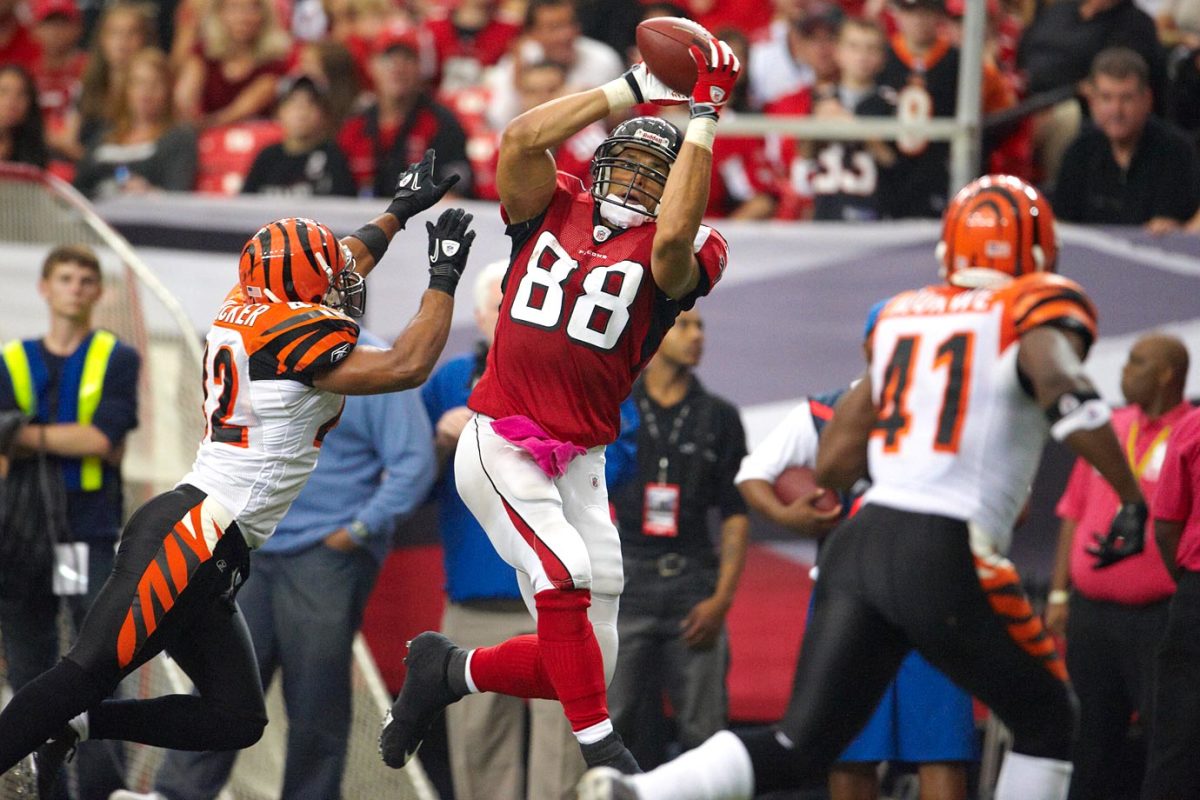
One of the most beloved players in Kansas City Chiefs' history, Tony Gonzalez said his final goodbyes to the only pro team he'd ever played for on April 24, 2009, when the Chiefs shipped the 10-time Pro Bowl tight end to the Falcons for a second-round pick. Gonzalez remained one of the league's elite tight ends, earning four more Pro Bowl appearances in five seasons in Atlanta, before retiring.
Brett Favre
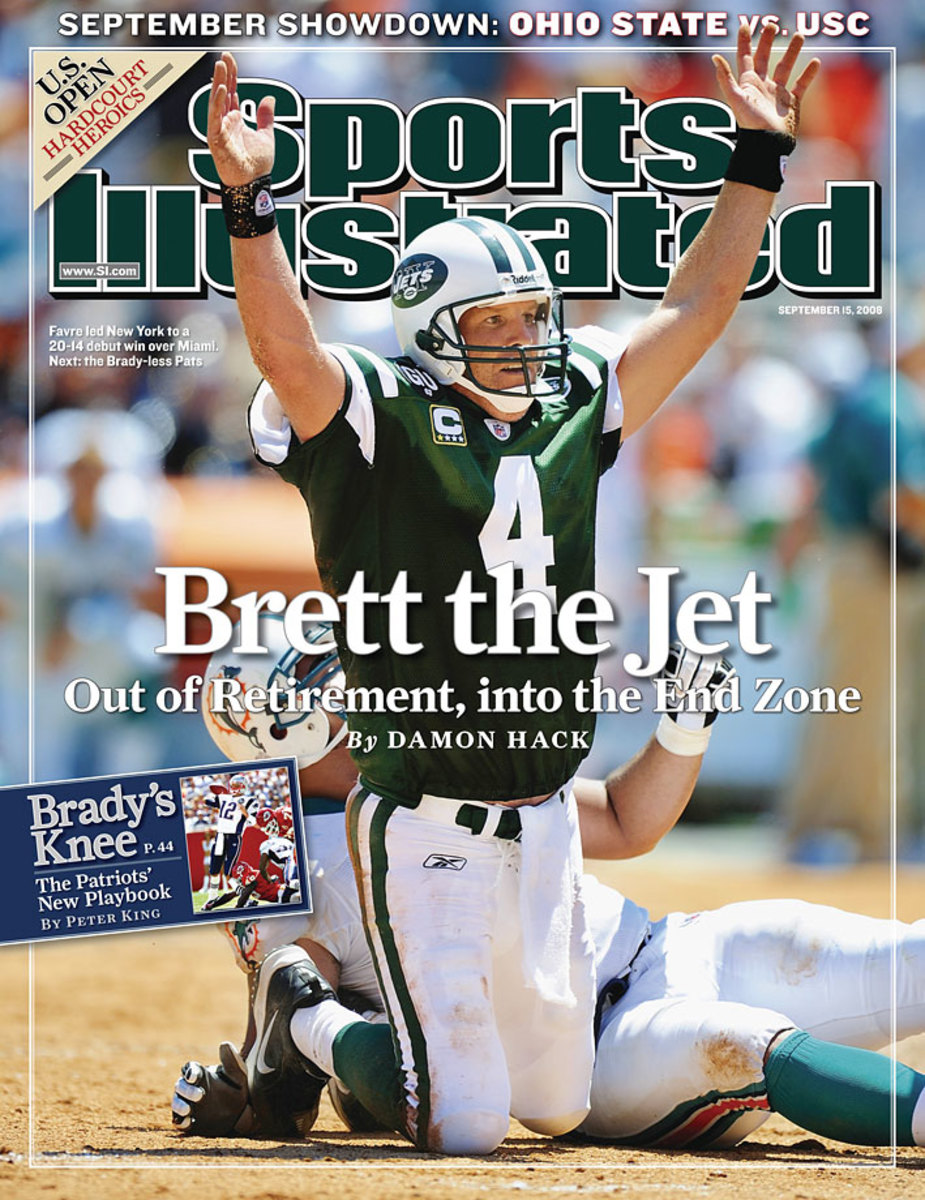
Brett Favre from the Packers to the Jets for a conditional draft pick. After 16 record-breaking seasons with Green Bay, Favre changed his mind on retiring and landed in New York. The three-time MVP and the Jets started out well but faded down the stretch; they missed the playoffs at 9-7 and he threw the same number of interceptions (a league-high 22) as touchdowns.
2007: Randy Moss
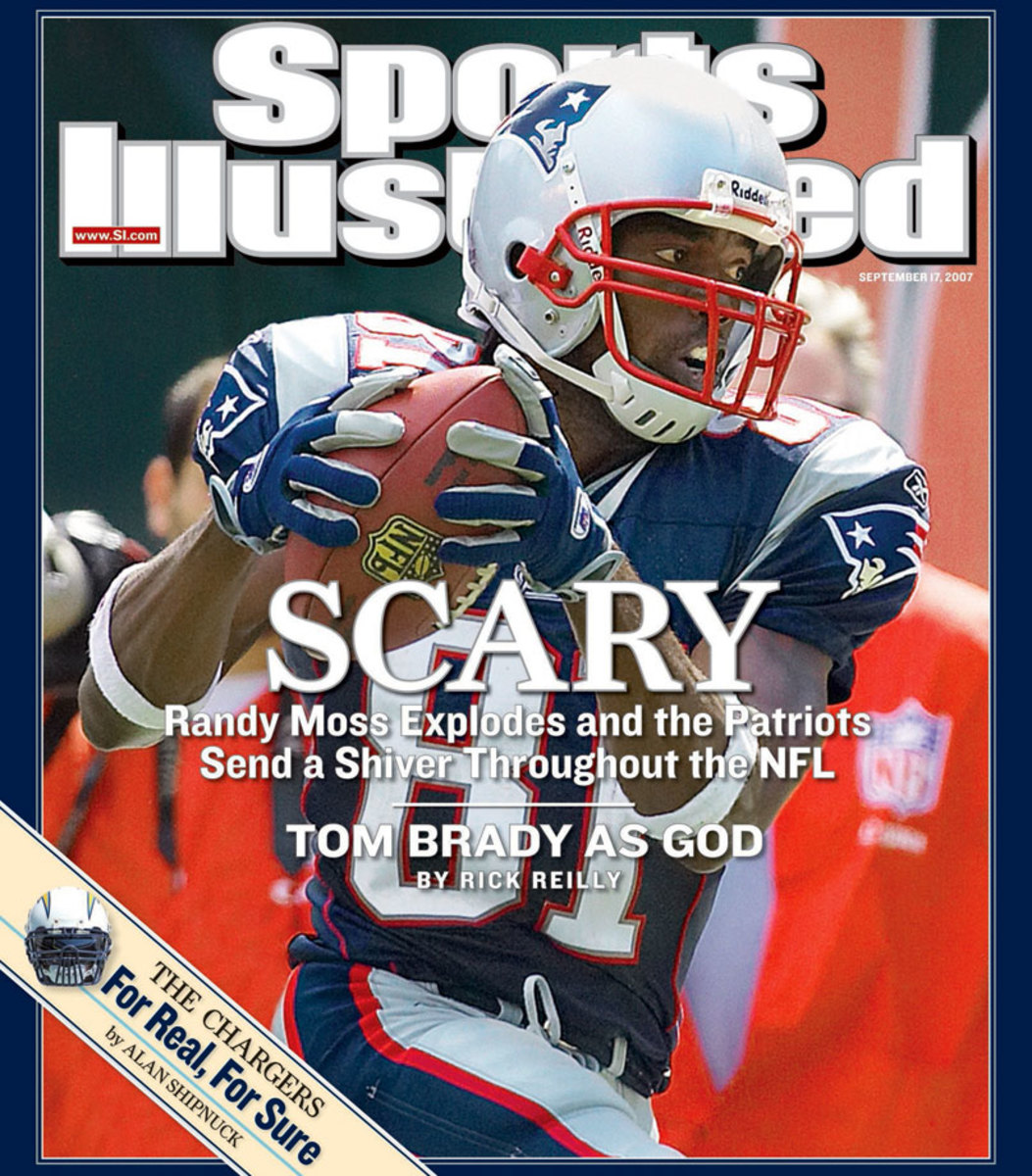
Randy Moss to the Patriots from the Raiders for a fourth-round pick. On draft weekend, the team-minded Patriots shocked the NFL by dealing for Moss, whose talent as a game-changing receiver had supposedly atrophied during his two mostly desultory seasons in Oakland. But Moss, as it turns out, was merely disinterested in losing, and his reemergence in New England coincided with the team's perfect regular season. Moss caught 98 passes for 1,493 yards and had a single-season NFL record 23 touchdowns. Not bad production in exchange for a fourth-round pick that Oakland used to select little-known University of Cincinnati cornerback John Bowie.
2004: Eli Manning, Philip Rivers
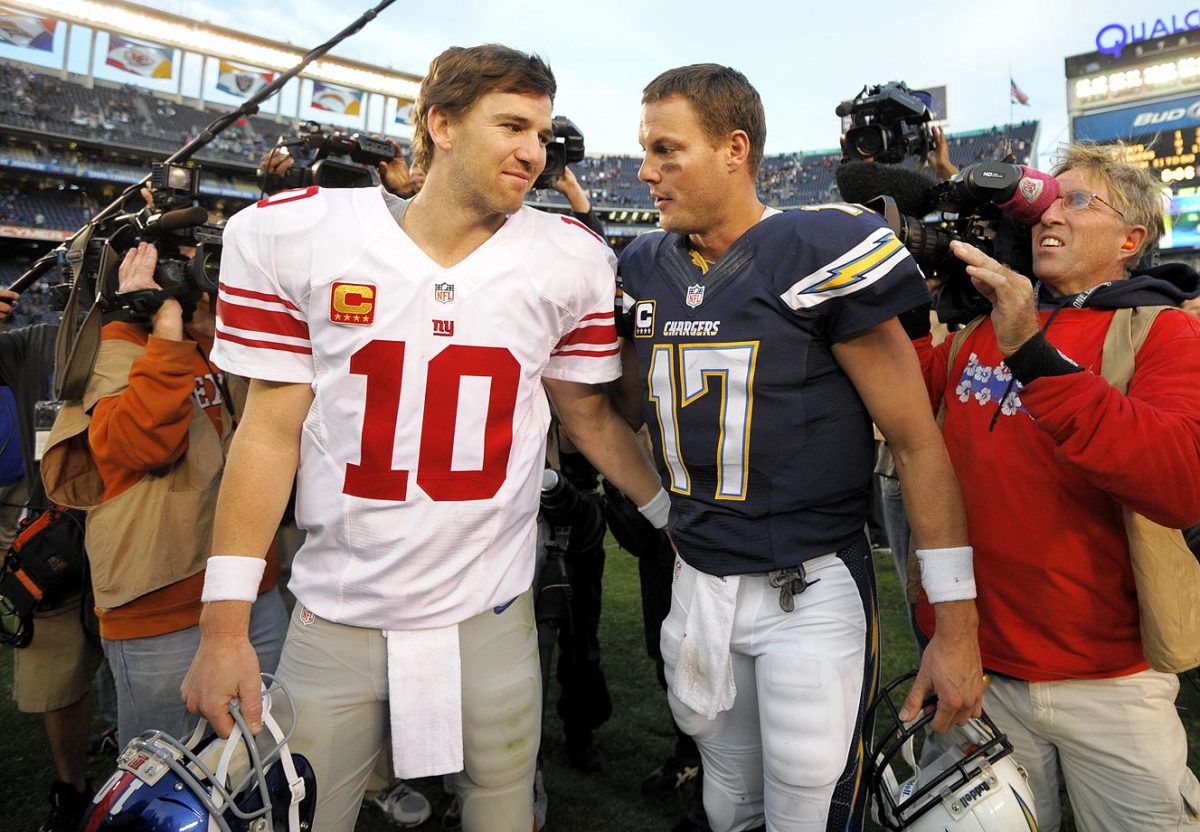
Eli Manning to the Giants for Philip Rivers and first-, third- and fifth-round picks. The draft-day deal saw Manning (taken first overall) and Rivers (No. 4) traded for one another shortly after being selected by the Chargers and Giants, respectively. It's difficult to pinpoint a bigger win-win trade in NFL history. The Giants landed the franchise quarterback who led them to two Super Bowl titles, including that memorable upset of the undefeated Patriots four years later, and the Chargers eventually reaped a windfall that included three future Pro Bowl players -- Rivers, linebacker Shawne Merriman and kicker Nate Kaeding -- and a veteran starting left offensive tackle in Roman Oben.
2004: Champ Bailey, Clinton Portis
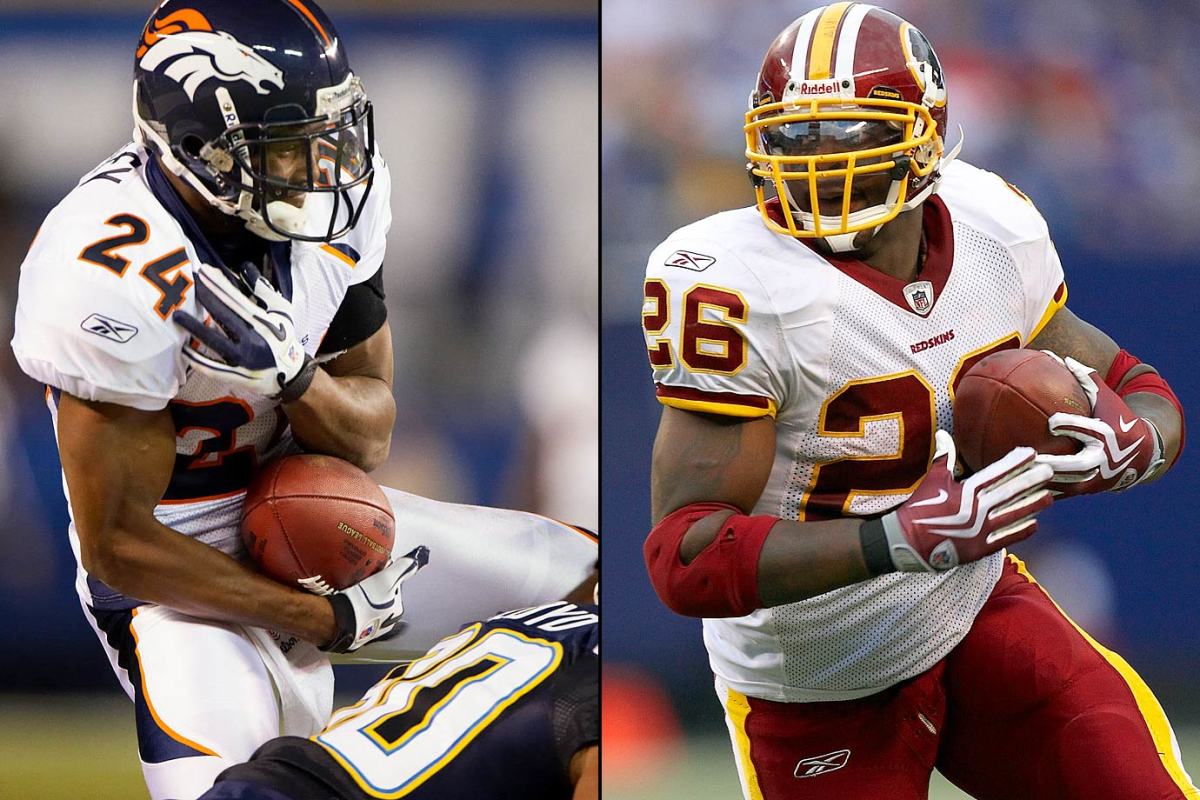
Champ Bailey and a second-round pick to the Broncos from the Redskins for Clinton Portis. One of the most intriguing and fair deals in NFL history saw the top cover cornerback in the game, Bailey (plus a draft pick that became running back Tatum Bell), go west while one of the league's top runners, Portis, headed to D.C.
2004: Terrell Owens
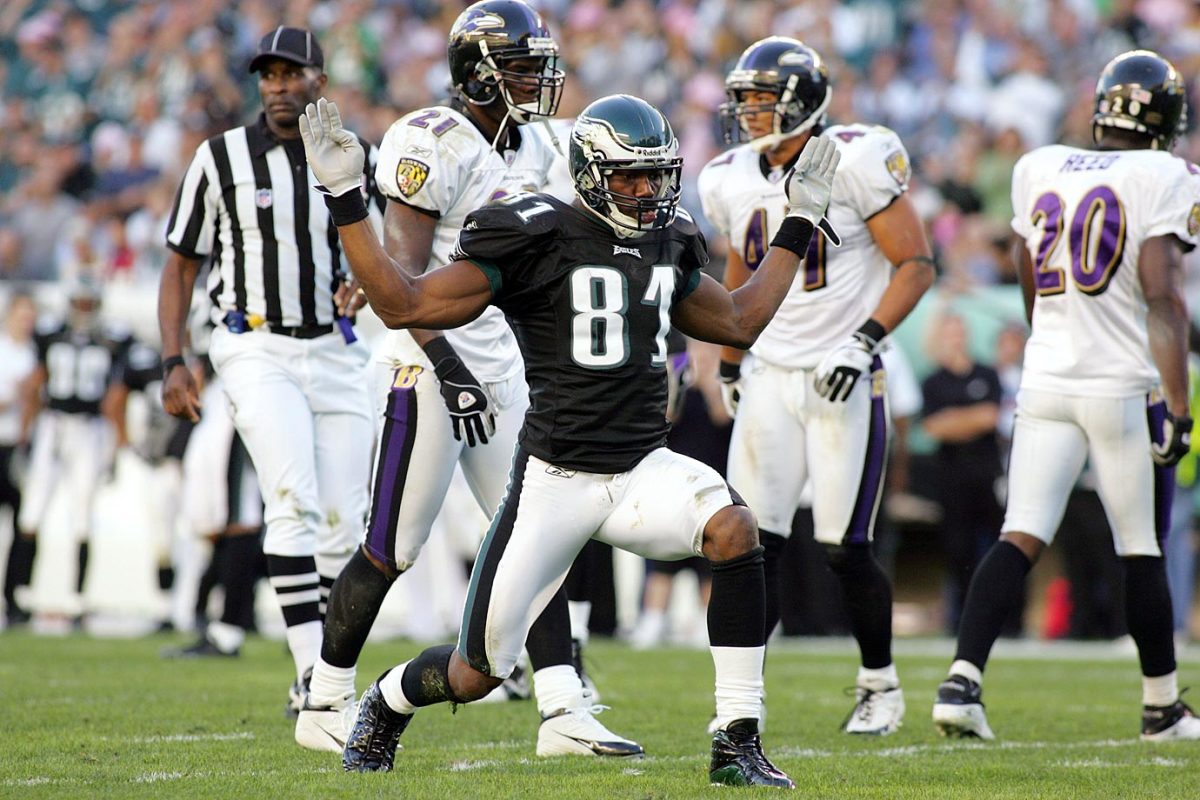
Terrell Owens to the Eagles from the Niners. You might forget that Owens blocked San Francisco's original deal with Baltimore, balking at the idea of joining the Ravens. Owens wanted to become an Eagle and play with Donovan McNabb, and he eventually got his wish when the three teams worked out a compromise that the NFL helped broker. (The Eagles sent a fifth-round pick to Baltimore and defensive end Brandon Whiting to S.F. The Ravens also recovered a second-rounder sent to the Niners for Owens.) The deal was a bonanza for Philadelphia that season, as Owens' big-play impact got the Eagles finally over their NFC title game hump and into the Super Bowl. But by '05, T.O. and McNabb were at war, and the Eagles' season was a casualty of the conflict.
2003: Drew Bledsoe
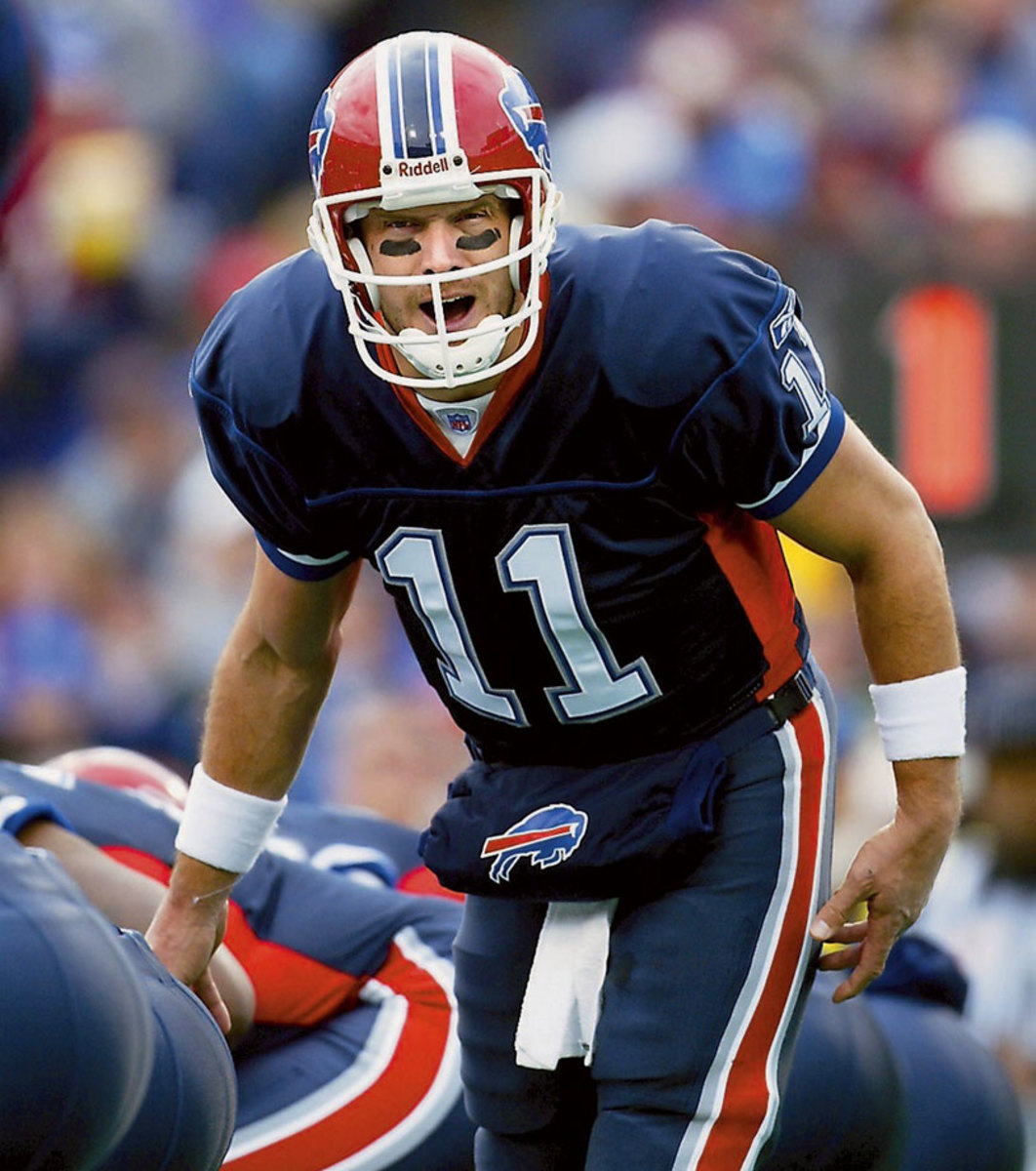
Drew Bledsoe to the Buffalo Bills for a first-round draft pick in 2003. The April 2002 trade of Bledsoe, a former first-round pick himself (1993), was fueled by the success Tom Brady had in replacing the injured Bledsoe in 2002. New England won a Super Bowl that season and obviously made the right move in shifting to Brady. Bledsoe spent three seasons in Buffalo and two in Dallas, where he was replaced by Tony Romo.
2002: Jon Gruden
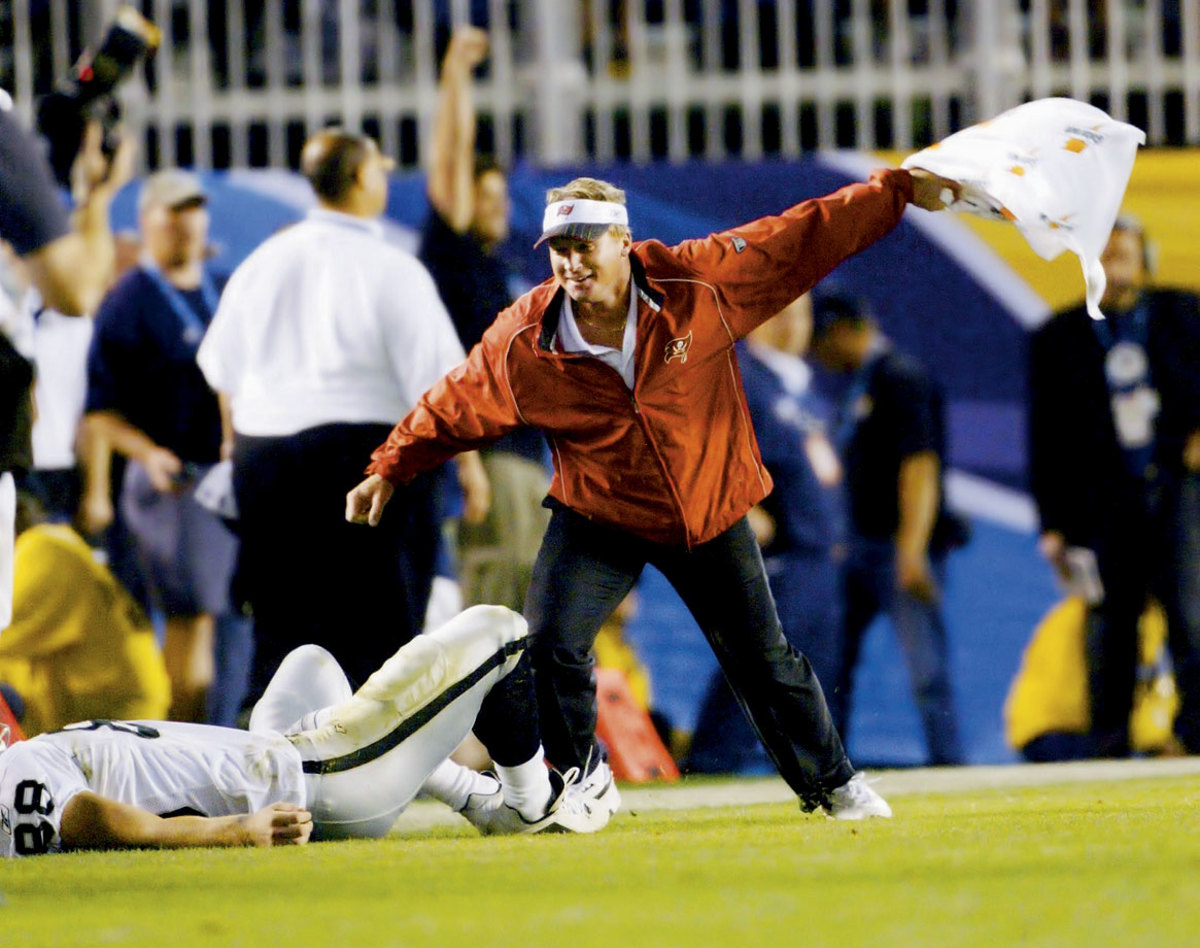
Jon Gruden to the Bucs from the Raiders for two first-round picks, two second-round picks and $8 million. Not content to field a perennial playoff team that habitually came up short once January arrived, Bucs owners Bryan and Joel Glazer fired beloved coach Tony Dungy and went looking for a replacement in January 2002. After fits and starts lasting almost two months, the Tampa Bay coaching search eventually turned toward Gruden, who had led Oakland to three straight playoff trips in four seasons. The Bucs sent a pirate's treasure to the Raiders in exchange for Gruden, but the move quickly paid off big time when he led the team Dungy had built to the franchise's only Super Bowl title, in January 2003.
2001: Michael Vick, LaDainian Tomlinson
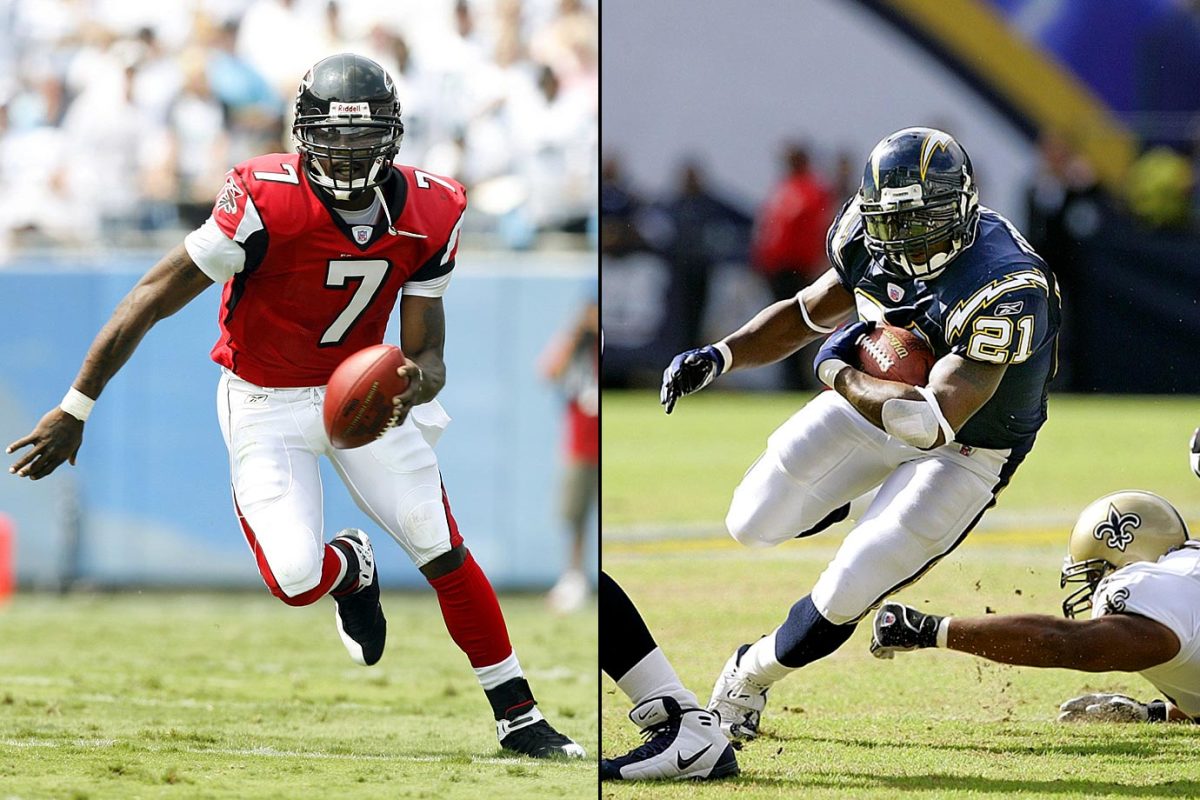
Chargers trade the first pick in the draft to the Falcons for the fifth pick in the first round, the fifth pick in the third, a future second-round pick and receiver Tim Dwight In what turned out to be a stroke of brilliance, the Chargers dealt the top pick that Atlanta used to take Michael Vick and wound up with the greatest runner of his era, LaDainian Tomlinson (at No. 5), along with cornerback Tay Cody and wide receivers Reche Caldwell and Dwight. The cherry on top for the Chargers came with the first pick in the second round when another QB, Purdue's Drew Brees, came into the fold.
